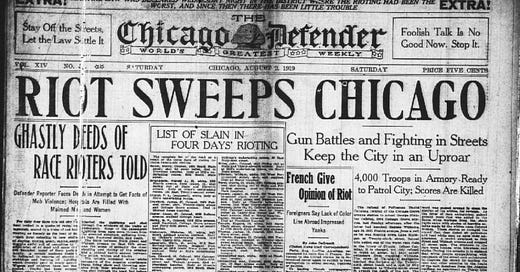Today is the anniversary of the Chicago anti-Black race war of 1919.
White violence against Black communities was so wide-spread in the United States that year that it became known as Red Summer.
Red for the color of the blood of Black Americans that flowed in the streets of cities across the country.
Harry Haywood was a young man who like many other young Black men had returned from the War to Chicago.
He wrote about Chicago’s Red Summer in his autobiography, Black Bolshevik.
The Chicago rebellion of 1919 was a pivotal point in my life. Always I had been hot-tempered and never took any insults lying down. This was even more true after the war. I had walked out of a number of jobs because of my refusal to take any crap from anyone. My experiences abroad in the Army and at home with the police left me totally disillusioned about being able to find any solution to the racial problem through the help of the government; for I had seen that official agencies of the country were among the most racist and most dangerous to me and my people.
I began to see that I had to fight; I had to commit myself to struggle against whatever it was that made racism possible. Racism, which erupted in the Chicago riot—and the bombings and terrorist attacks which preceded it—must be eliminated. My spirit was not unique—it was shared by many young Blacks at that time. The returned veterans and other young militants were all fighting back. And there was a lot to fight against. Racism reached a high tide in the summer of 1919. This was the "Red Summer" which involved twenty-six race riots across the country—"red" for the blood that ran in the streets. Chicago was the bloodiest.
The holocaust in Chicago was the worst race riot in the nation's post-war history. But riots took place in such widely seperate places as Long View, Texas; Charleston, South Carolina; Elaine, Arkansas; Knoxville, Tennessee, and Omaha, Nebraska. The flareup of racial violence in Omaha, my old home town, followed the Chicago riots by less than two months. It resulted in the lynching of Will Brown, a packing house worker, for an alleged assault on a white woman. When Omaha's mayor, Edward P. Smith, sought to intervene, he was seized by the mob. They were close to hanging the mayor from a trolley pole when the police cut the rope and rushed him to a hospital, badly injured.
The common underlying cause of riots in most of the northern cities was the racial tension caused by the migration of tens of thousands of Blacks into these centers and the competition for jobs, housing and the facilities of the city. Rather than being at a temporary peak, this outbreak of racism was more like the rising of a plateau—it never got any higher, but it never really went down, either. Writing in the middle of a riot in Washington, D.C., that summer, the Black poet Claude McKay caught the bitter and belligerent mood of many Blacks:If we must die, let it not be like hogs
Hunted and penned in an inglorious spot,
While round us bark the mad and hungry dogs,
Making their mock at our accursed lot.
If we must die, O let us nobly die
So that our precious blood my not be shed
In vain; then even the monsters we defy
Shall be constrained to honor us though dead!
O kinsmen! We must meet the common foe!
Though far outnumbered let us show us brave,
And for their thousand blows deal one death blow!
What though before us lies the open grave?
Like men we'll face the murderous, cowardly pack,
Pressed to the wall, dying, but fighting back





I think you know what happened. All across America young blacks who had gone to war for our nation and thought they had proved their worth and equality. So they did something, maybe swim into the wrong beach, maybe no show deference, and they scared the hell out of the whites. And the riots started.